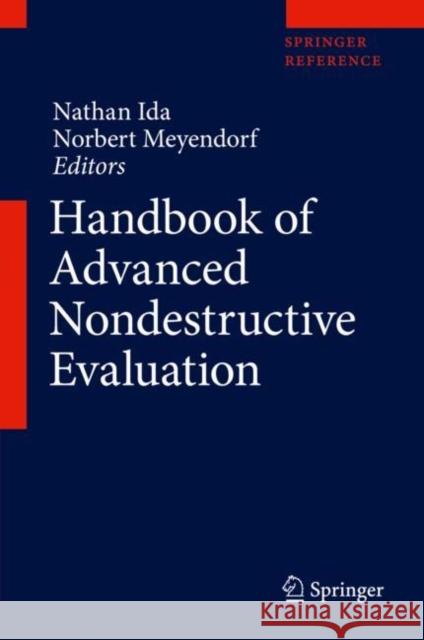Handbook of Advanced Nondestructive Evaluation » książka



Handbook of Advanced Nondestructive Evaluation
ISBN-13: 9783319265520 / Angielski / Twarda / 2019 / 1609 str.
Handbook of Advanced Nondestructive Evaluation
ISBN-13: 9783319265520 / Angielski / Twarda / 2019 / 1609 str.
(netto: 3450,56 VAT: 5%)
Najniższa cena z 30 dni: 2698,88
ok. 22 dni roboczych
Dostawa w 2026 r.
Darmowa dostawa!
This handbook is a comprehensive source of information on all aspects of non-destructive testing (NDT), for use by professionals, educators, and most of all, by the practitioners of testing.
Nathan Ida is currently distinguished professor of Electrical and Computer Engineering at The University of Akron in Akron, Ohio, where he has been since 1985. His current research interests are in the areas of electromagnetic nondestructive testing and evaluation of materials at low and microwave frequencies with particular emphasis on theoretical issues, on all aspects of modeling and simulation and on related issues stemming from research in NDE. Starting with modeling of eddy current and remote field phenomena, and continuing with high frequency methods for microwave NDE, his work now encompasses the broad aspects of computational electromagnetics where he has contributed to both the understanding of the interaction of electromagnetic fields with materials and the development of new methods and tools for numerical modeling and simulation for, and beyond, NDE. Other areas of current interest include electromagnetic wave propagation, theoretical issues in computation, as well as in communications and sensing, especially in low power remote control and wireless sensing. Much of this work has found its way into practice through industrial relations and consulting across industries as diverse as power generation, polymers, steel, medical, and software, spanning the globe. Dr. Ida has published extensively on electromagnetic field computation, parallel and vector algorithms and computation, nondestructive testing of materials, surface impedance boundary conditions, sensing, and others, in over 400 publications. He has written nine books: two on computation of electromagnetic fields (one in its second edition), one on modeling for nondestructive testing, one on nondestructive testing with microwaves, a textbook on engineering electromagnetics (now in its fourth edition), a textbook on sensing and actuation (now in its second edition), a book on the use of surface impedance boundary conditions, and others, including on ground penetrating radar and industrial sensing based on microwaves. Dr. Ida is a life fellow of the Institute of Electric and Electronics Engineers (IEEE), a fellow of the American Society of Nondestructive Testing (ASNT), a fellow of the Applied Computational Electromagnetics Society (ACES), and a fellow of the Institute of Electronics and Technology (IET). Dr. Ida teaches electromagnetics, antenna theory, electromagnetic compatibility, sensing, and actuation, as well as computational methods and algorithms. Dr. Ida received his B.Sc. in 1977 and M.S.E.E. in 1979 from the Ben-Gurion University in Israel, and his Ph.D. from Colorado State University in 1983.
Norbert Meyendorf retired in fall 2018 as deputy director of the Center for Nondestructive Evaluation and professor in the Aerospace Engineering department at the Iowa State University in Ames, Iowa. Before joining ISU in 2016 he had several appointment and ranks. The most recent are: Branch Director at the Fraunhofer Institute for Nondestructive Testing IZFP and later IKTS, director of the International University of Dayton/Fraunhofer Research Center at the School of Engineering at the University of Dayton, organizing collaborative projects between Fraunhofer and University of Dayton, and Program Director of the Master program “Nondestructive Testing, M. Sc. (NDT)” at the Dresden International University (DIU) between 2011 and 2015. Norbert Meyendorf continues to be active as adjunct professor for micro- and nano-NDE at the University of Dresden and adjunct professor at the Department for Chemical and Materials Engineering, University of Dayton. He is the author or coauthor of more than 300 peerreviewed journal articles, contributions to edited proceedings, technical reports, and numerous oral presentations on conferences, meetings, workshops, etc. He is editor in chief of the Journal of Nondestructive Evaluation and edited several books and conference proceedings. His areas of expertise include solid state physics and physical analytics, welding metallurgy, materials testing, nondestructive evaluation (NDE), and structural heath monitoring (SHM), for instance. Since 2001, he has been chairman or co-chairman of several conferences within the SPIE International Symposium on Nondestructive Evaluation for Health Monitoring and Diagnostics and later the Symposium for Smart Structures and NDE. In 2005, 2006, 2012, and 2013, he was chair or co-chair of the whole SPIE Symposium. In 2018 he became fellow of SPIE. Norbert Meyendorf was founder and chair of two expert committees of the German Society for Non-Destructive Testing (DGZfP), the Expert Committees for “Structural Health Monitoring” and “Materials Diagnostics.” Between 2016 and 2018, he reorganized and directed the ASNT Section Iowa.
This handbook is a comprehensive source of information on all aspects of non-destructive testing (NDT), for use by professionals, educators, and most of all, by the practitioners of testing. The art of NDT consists of dozens of methods, some classical, and some emerging. As the pace of industrial work and discovery intensifies and materials are utilized to their physical limits, the role of NDT becomes ever more important. As a result, the methods of testing are themselves evolving, and it is the intent of this book to capture this evolution.
Handbook of Modern Non-Destructive Testing broadens the scope from traditional books on the subject. In addition to classical, emerging and exotic methods of evaluation, the book will also cover the use of NDT techniques in other fields, such as archaeology or resource exploration. With contributions from experts in all areas of the field, the reader will find balanced coverage of a variety of testing methods, with no bias against
or endorsements of any particular method. The book treats many areas in depth, covering all aspects of testing, and will include case studies where appropriate. Additional coverage of statistical methods and their use, as well as simulations‘ role in testing and test design, are included.1997-2025 DolnySlask.com Agencja Internetowa
KrainaKsiazek.PL - Księgarnia Internetowa









